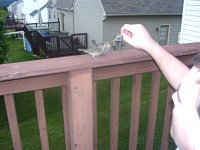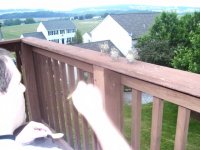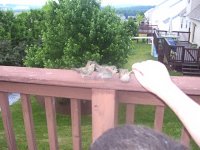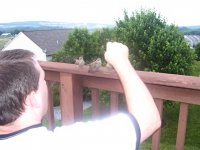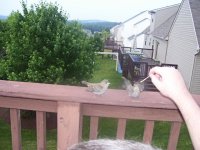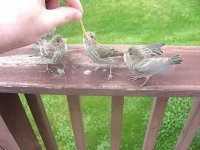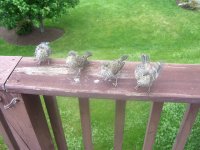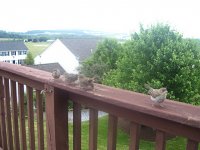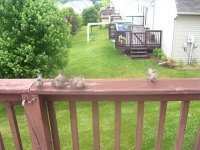Wabby, you've been a big help!
Wabby Twax,
I found this site yesterday while frantically looking for information about caring for two abandoned nestlings which I think are house sparrows. I discovered them yesterday in my garden. Before I could get both to safety, a cat came along and grabbed one of them. I've been caring for the remaining one since this time yesterday. It's doing quite well considering it must have fallen from its nest, which I could not find in the large evergreen trees on our property. My husband thinks a cat may have knocked the nest and caused the nestlings to tumble out. While comparing pictures that are posted online, I think this little guy is about 9 days old. Wabby, I noticed that your post is from York, PA. I live near Reading, PA. I hope that this little bird will do as well as your brood. I am feeding it a mixture of cat kibble soaked in water, canned dog food (beef), hard-boiled egg yolk, and peanut nuggets (a high energy food with suet and roasted peanuts) which are soft and mix easily with the other ingredients. Any other suggestions from you or anyone else reading these posts would be welcome. I am a bird watcher with several bird feeders and lots of trees, bushes and shrubs on and around our house. We have tons of birds but also lots of neighborhood cats. It's a welcoming area for birds but can also be very dangerous. If I can figure out how to send a picture, I will send one along later today. Wish me luck!
Wabby Twax,
I found this site yesterday while frantically looking for information about caring for two abandoned nestlings which I think are house sparrows. I discovered them yesterday in my garden. Before I could get both to safety, a cat came along and grabbed one of them. I've been caring for the remaining one since this time yesterday. It's doing quite well considering it must have fallen from its nest, which I could not find in the large evergreen trees on our property. My husband thinks a cat may have knocked the nest and caused the nestlings to tumble out. While comparing pictures that are posted online, I think this little guy is about 9 days old. Wabby, I noticed that your post is from York, PA. I live near Reading, PA. I hope that this little bird will do as well as your brood. I am feeding it a mixture of cat kibble soaked in water, canned dog food (beef), hard-boiled egg yolk, and peanut nuggets (a high energy food with suet and roasted peanuts) which are soft and mix easily with the other ingredients. Any other suggestions from you or anyone else reading these posts would be welcome. I am a bird watcher with several bird feeders and lots of trees, bushes and shrubs on and around our house. We have tons of birds but also lots of neighborhood cats. It's a welcoming area for birds but can also be very dangerous. If I can figure out how to send a picture, I will send one along later today. Wish me luck!




